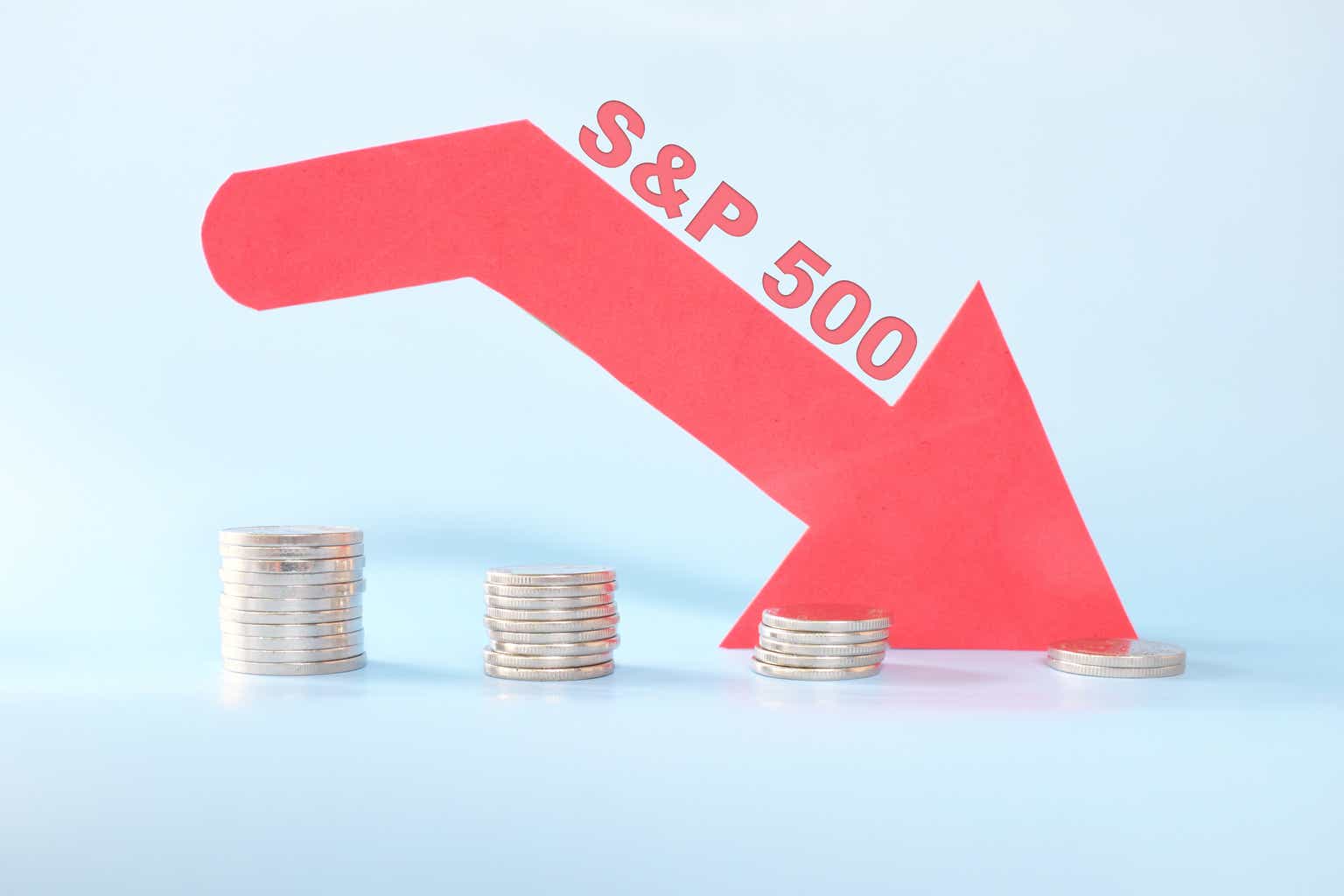Investment thesis: On the surface, it may look like the Federal Reserve may have managed the worst flareup in inflationary pressures in the past four decades rather well. Inflation is down, while the economy is yet to show clear signs of a hard landing. Based on this first glance, investors should be gearing up for a good year in 2024. I cannot help but take a contrarian position and predict that the S&P 500 (SPX) will decline to 3,500 by the end of 2024. The reasons to expect such a steep decline are many. They range from potentially higher oil prices preventing interest rates from declining as much as hoped, to a slowing economy, driven in large part by consumer demand faltering putting the squeeze on profits. Furthermore, macroeconomic expectations for 2025 will probably be slashed by major institutions due to several perceived or very real negative factors, which will not help the markets finish next year very strong as investors will look forward to 2025, as 2024 will draw to a close. Given the high potential for poor fundamentals next year, as well as a market that is currently arguably overpriced, there is in my view enough room for the S&P to fall enough to make 2024 potentially the second-worst year of this century for the composite.
A historical look at S&P performance & valuation
S&P 500 yearly gains/losses (Macrotrends)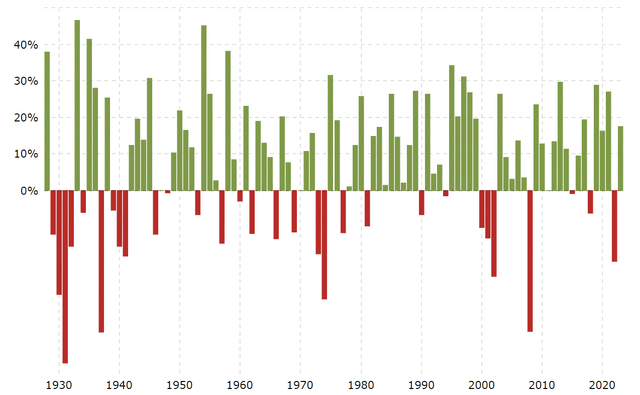
Assuming that the S&P 500 will finish the year at current levels as I write this, in the 4,700 range, if I am correct about next year and the S&P 500 will finish 2024 at 3,500, it will amount to a decline of about 25%, which will make it the second-worst full year performance for the S&P this century.
My forecast may seem dramatic, but it does not necessarily take a year of dramatic events to make it happen.
S&P 500 P/E chart (Multipl.com)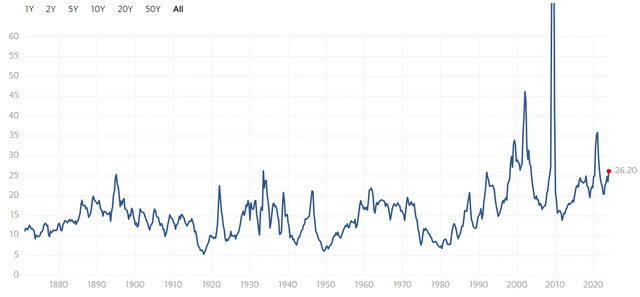
The simple fact that the S&P 500 trades currently at a P/E multiple of over 26, while historically it has been trading at around 16, makes for a lot of potential downside. It has been argued that with the low-interest rates in the 2009-2021 period, the stock markets can trade at higher multiples, without necessarily becoming overpriced.
It seems that the market expects that the current higher interest rate environment will be just an anomaly and we will return to lower interest rates. Talk of the Federal Reserve moving toward lowering interest rates as soon as the spring seems to be a major factor in the market accepting such a high P/E ratio. Any indications that a reduction in interest rates will not be forthcoming would probably trigger a correction toward a historical level of P/E. The return to a historically normal P/E alone would be enough to make my prediction of the S&P at 3,500 by the end of 2024 a reality, assuming a decline from current S&P 500 index price levels. I do not foresee the market going all the way down to historical P/E averages, but perhaps a move to about 20 or so might be expected if higher interest rates persist.
I should note that in a worst-case scenario, where the market gives up on lower interest rate expectations, and moves to a historical P/E level, combined with lower economic growth leading to earnings being cut in half, would fundamentally justify an S&P 500 year-end price level of about 1,500. As is often the case, however, in a recessionary environment, P/E ratios tend to spike higher as the chart above shows, with the 2009 market being the most obvious case. In other words, there tends to be a great deal of resistance to the market adjusting to lower earnings. For this reason, while straightforward calculations might bring us to an assumption that we could be on the verge of a catastrophic selloff expectation, things are never that simple and it shows the limitations of attempting to calculate one’s way to a forecast outcome for the markets. Calculations can play a role, but it should be understood that it is more complicated than this.
Factors to watch in 2024 that are likely to impact the market
- A slowing US & global economy poses a risk to earnings, while the potential for higher oil prices despite a slowing economy, threatens prospects of expected and arguably priced-in interest rate cuts.
In the short term, the markets tend to cheer any bad economic news that might suggest a resulting downward shift in the current interest rate. There seems to be a growing sense that the US & the global economy is starting to slow significantly. Institutions such as the IMF keep downgrading the outlook for the global economy for 2024, with the latest prediction suggesting that global growth will come in at 2.9%. The Federal Reserve Bank of St. Louis estimates US growth will slow from 2.6% this year to just 1.3% next year.
At this point, I am inclined to believe that the downside risks to current US & global GDP growth forecasts for next year outweigh any chance of upside surprises. As I pointed out in a recent article, crude oil prices could potentially spike next year, which in turn has the potential to slow down the global economy, directly as well as indirectly. It can slow it down directly, as consumers are forced to spend more on energy. It would also probably stand in the way of lowering interest rates due to renewed concerns about inflation. The market arguably already priced in strong odds of significant interest rate cuts next year, which is evidenced by the P/E ratio that is persistently higher than historical averages. In other words, the economic slowdown may materialize, while the expected resulting lower interest rate environment may not necessarily materialize. To make matters worse, not only will cuts in interest rates fail to materialize in such a stagflationary scenario, but earnings are likely to take a big hit.
- The EU & China both look economically vulnerable, with potential trade frictions threatening to push both economies over the edge.
China’s economy seems to have suffered permanent scarring after staying closed for the COVID crisis longer than most other major economies, in an arguably futile effort to maintain a zero-infection policy. Even after it opened, trade frictions and other headwinds caused its economy to remain stuck in low-growth mode.
China GDP growth forecast (Statista)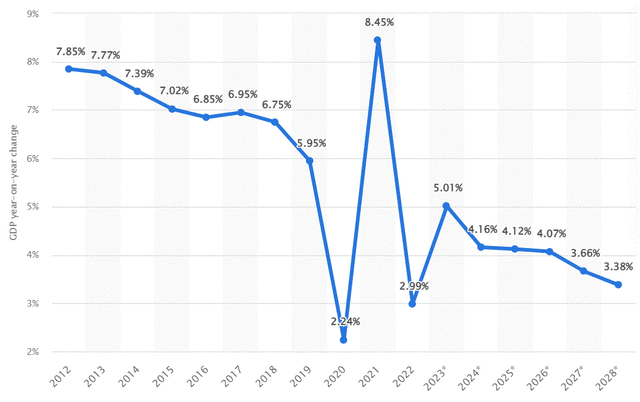
There is of course no telling whether any of the forecasts floating around have much merit. The way I see it, trade and tech war tensions, as well as internal issues such as its real estate problems, as well as the long-term drag of low birth rates do not bode well for China’s economic future. There are some potential bright spots, such as its economy being able to catch up technologically to the US, despite the sanctions that were put on its tech imports. Between rising trade frictions as well as its real estate issues, we could easily see a negative surprise next year coming out of China.
Europe’s economy has arguably stagnated and has been limping along for at least a decade and a half now, ever since the 2008 crisis. Despite all the challenges, starting with the euro crisis, then the Ukraine war, Brexit, the migrant crisis, and all the associated negative economic impacts that came with these events and trends, the EU managed to keep it together thus far, which is mistakenly seen as a sign of resilience. The fact that the EU managed to avoid outright implosion, does not mean that all these problems did not take a heavy toll on the continent’s economic well-being. For instance, average net salaries in the EU’s main economies are only about half on average compared with the US.
Europe average net wages (Wikipedia)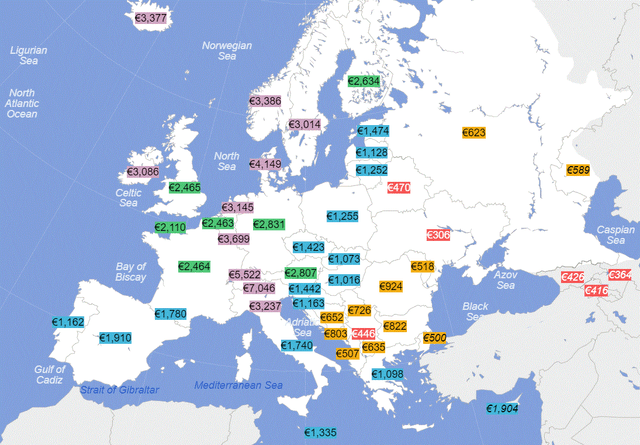
The buying power of European consumers is much diminished, while its technological stagnation relative to the US & China seems to be accelerating. On top of that, there has been an ongoing energy insecurity crisis since the start of the decade, a disastrous demographic trajectory, and rising political and ideological tensions within the EU as well as within individual nations. Odds are that the already fragile EU economy will continue to struggle and it could easily spiral into a crisis in 2024. Europe’s rising economic frictions with China are not helping either. The main potential triggers of a crisis in Europe that I see as possible include a new energy crisis, and a potential sovereign debt crisis, with several major economies such as Italy and even France in less-than-ideal fiscal shape.
If there is to be a major shock to the global economy, the top contender to provide that shock would be an EU economic & political crisis. In second place would be a negative development in China. That is not to say that there are no issues in the US, Japan, and elsewhere. US deficits, and Japan’s massive debt pile all contribute to what I see as a fragile global economic situation, which makes for a dangerous environment for investors next year and beyond. The way I see it, the odds of something going wrong next year, triggering a global economic crisis are high.
- Splitting the world into two rival blocks is already taking a toll on global trade.
At the start of the year, I predicted that China’s 2025 policy might become the investment story of the year. In other words, this will be the year when China’s technological advancements will serve to disrupt our current global dominance in the tech sector. The signs that it is happening did emerge this year, with Huawei leading the way, proving those who believed in technological containment as a viable China policy wrong. However, the story overall did not prove to be such an important investment theme as I thought it would, perhaps because it arrived late in the year. It does play a role in the greater picture emerging of the global economy, where we are seemingly starting to see a split of the world into two camps. One is led by China, through organizations such as BRICS, as well as the SCO, and the other by the US.
The tearing of the world into two rival factions is made possible to a large extent by China’s ability to declare a higher level of technological independence, giving other countries around the world the choice of not having to be overly dependent on Western technology. It was exacerbated by the Ukraine war, and our attempts to isolate Russia economically, which was perhaps the clearest indication of where the contours of the split are taking shape, evidenced by the resistance of much of the World to participate in attempts to isolate Russia economically.
Though there is not always a lot of attention on the trend within the markets, we do see signs of economic deglobalization taking place as a result of worsening international relations. It was recently estimated that global trade is set to decline by around $2 Trillion, or 8% this year, compared with the previous year. It is also noted that trade is growing among aligned states while opposing states are seeing a significant decline in trade. It is expected that the trend is likely to continue next year, which might come with some unexpected consequences, such as higher inflation, an overall diminution of consumer buying power, and perhaps diminished opportunities for companies to access foreign markets.
Factors that could derail my thesis:
The greatest risk to my thesis is arguably a failure of the oil market to rally. Global oil demand may be in decline or about to decline, and institutions such as the IEA & OPEC could be oblivious to the trend. If this is the case, it will not impede the Federal Reserve’s plan to lower interest rates next year. In that event, the S&P could head in the opposite direction and next year we could see a constant upward march of the markets to new record highs. I see the odds of this happening as being somewhat low, but it is not impossible.
A sudden global rapprochement that would reverse the current trend of declining global trade could also play a role in driving inflationary pressures down. It might be enough to provide the Federal Reserve with enough room to go through with interest rate cuts, without having to worry too much about a return of inflationary pressures. In a world of plenty, an accommodative monetary policy is more likely to spark an asset inflation trend than it is to spark actual inflation in goods & services.
Investment implications:
Around this time last year, I wrote a similar article dedicated to predicting where the S&P 500 was headed for this year, where I argued that it would grind higher to 4,200. With less than two weeks to go, it does seem that I underestimated the upside potential for the markets this year, while I can still take some credit perhaps for getting the direction of the market right. The fact that I may miss the mark by a wide margin for this year underscores the difficulty in applying macro-analysis expectations to building one’s investment portfolio. I would not call it useless, because it can have value, but it should be accompanied by other strategies meant to reduce risk and improve the odds and magnitude of positive returns on investment.
While providing a market forecast with a high degree of accuracy in any given year is not an easy task by any means, a multi-year view of macro trends and factors, as they evolve, is easier to predict to some extent in my view and it does tend to provide for an improved long-term strategy in terms of investment allocations by sectors, industries, individual companies and so on. An exercise in producing a one-year forecast within the context of a longer-term viewpoint helps to focus the mind on more immediate investment opportunities. For instance, my overall broader view that contributed to my forecast for a significantly down year for the S&P 500 for 2024 is the continued tightness in the global liquid fuels supply/demand situation, which in effect acts as a limiting factor in terms of maximum potential global economic growth that can be achieved. I see it as an important issue for the decade as a whole, with related or unrelated demand destruction events being the only factors that can prevent oil price spikes.
Based on OPEC’s latest report, for the first two months of the current quarter, global liquids supplies averaged about 102 mb/d. OPEC estimates that global demand for the current quarter will be just under 103.3 mb/d, meaning that for the current quarter overall we will see a supply deficit of about 1-1.5 mb/d, assuming no surprises will occur this month. What this means for me is that my strategy of being overweight on upstream oil producers is the correct place to be, now as well as next year, even if the market does not seem to agree at the moment. I currently own Suncor (SU), and Canadian Natural Resources (CNQ) as my main positions in upstream oil producers, and these two companies combined make up about a fifth of my total stock portfolio.
Most stocks that depend on discretionary consumer demand are perhaps good candidates to sell and take some profits in the next few months, as markets will probably be too busy celebrating the path toward future interest rate cuts, to notice that commodities-based inflation is likely to pick up pace, led by oil prices. I just exited my stock positions in AMD (AMD) and Intel (INTC) where I am up significantly on both and I am looking to take profits, while I am also looking to end my position in Ford (F), Nokia (NOK) as well as DOW Inc (DOW). I am currently down on all three of these stocks and I am looking for a favorable exit point. I also just sold my Chesapeake (CHK) stock position at a slight gain. It was a bet on a global LNG market boom creating higher demand for US natural gas, which does not seem to be in the cards, given a relatively tame winter so far as well as arguably weak global industrial demand for natural gas, due to a lack of strong economic growth prospects.
Overall, within the context of my assumption of the S&P 500 ending the year 2024 at 3,500 points thesis, I see the first six months of next year as an opportunity to take some profits or to reduce losses from poor bets from the past. The second half of the year will present investors with an opportunity to pick up stocks at better price points. There is of course some risk to my thesis, namely that interest rates will go lower without inflationary pressures making a comeback. For instance, if the OPEC reports of a current liquid fuels supply shortfall turn out to be wrong, there will be no oil price spike.
Global trade could also see a reverse of its current trend of shrinking, which would improve consumer access to affordable goods. If there are no shortages in the real economy, most of the cheap money will flow toward asset inflation, including in stocks, as was the case in the 2009-2022 period. If that is the case, my current strategy to have ample cash on hand, ready to deploy in case there is a significant and broad decline in stock prices, will prove to be a less-than-ideal strategy for next year and beyond. I am currently holding about 30% of my portfolio in cash, which might increase in the next few months if I am correct about where the market is headed and I will further reduce some of my stock holdings.
If I am correct about the trend of the market for the coming year, we should see a continued rally in stocks, perhaps until about summer. In other words, we will most likely reach 5,000 points in the S&P 500 before we get to 3,500. If I am also correct about the trigger event that will cause a reversal of the market, namely an oil price spike, then I will probably reduce my current oil stock positions, selling into the oil rally. In the second half of the year, I will start looking to buy mostly high-quality stocks that will be dragged down by the overall market. I will likely buy back many of the same stocks I intend to sell in the next few months, once the price is right.
I have an investment plan for the coming year and I hope it will turn out more or less the way I expect, but there is always a somewhat high probability that it will not. In that case, my main challenge will be to employ some of my cash within an investment environment that I am generally not inclined to buy into. In other words, many of the stocks I might want to invest in could be at or close to all-time highs, which I tend to avoid.
While markets that are reaching new all-time highs, and pushing higher do not offer great long-term entry points, there is always something cyclical that fails to participate in the broader market rally. For instance, even though the S&P 500 is up over 20% YTD as I write this, Albemarle (ALB) is down over 30% now, and it was down, even more earlier, which made it a good buying opportunity this year, along with other lithium miners. There are always buying and selling opportunities, regardless of the overall market trends. A mental exercise in looking at factors that might drive overall market trends, such as my market prediction for 2024 helps with creating an overall investment strategy, but that strategy should always allow for the flexibility needed to adjust to unforeseen outcomes.
Editor’s Note: This article was submitted as part of Seeking Alpha’s 2024 Market Prediction competition, which runs through December 20. With cash prizes, this competition — open to all contributors — is one you don’t want to miss. If you are interested in becoming a contributor and taking part in the competition, click here to find out more and submit your article today!
Read the full article here
